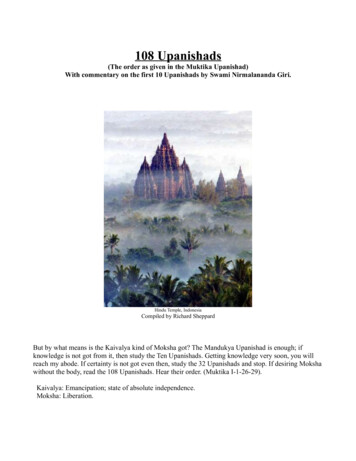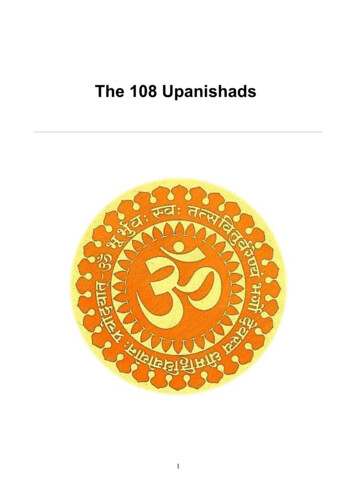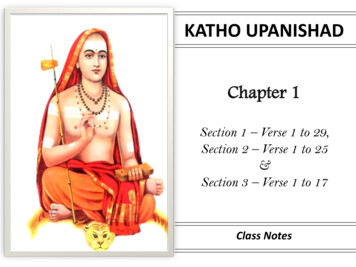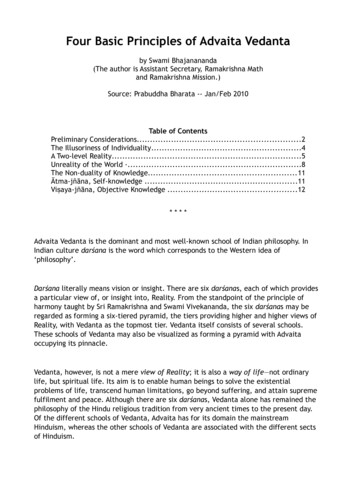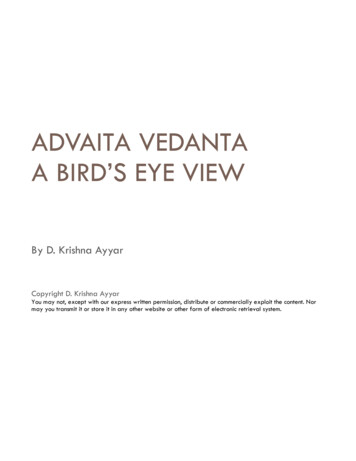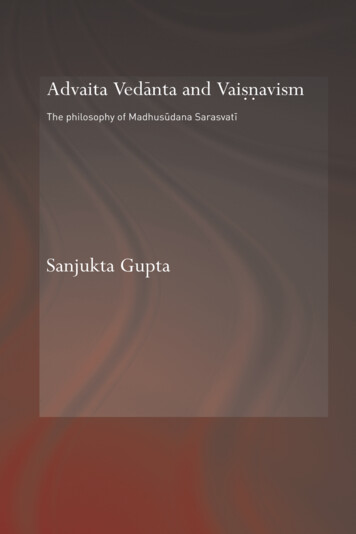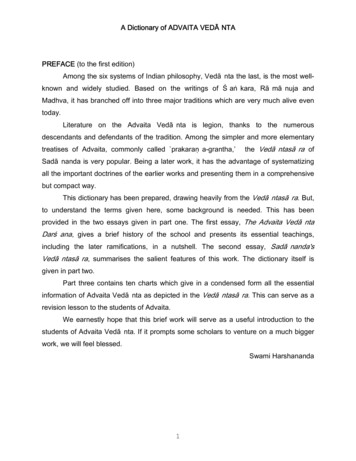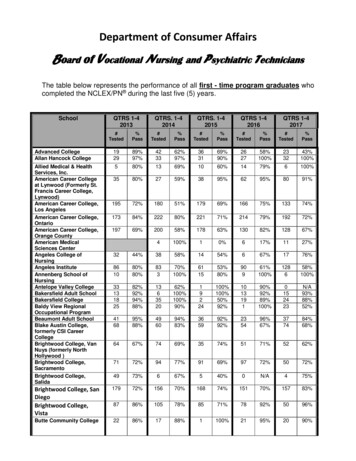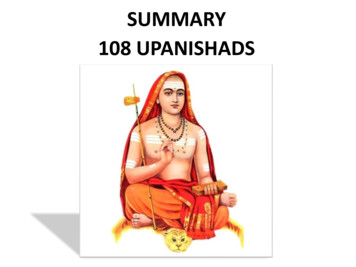
Transcription
SUMMARY108 UPANISHADS
IndexS. No.TitlePage No.1. Introduction12. Aitareya Upanishad93. Chandogya Upanishad114. Kena Upanishad145. Isa Upanishad166. Brihadaranyaka Upanishad187. Katha Upanishad208. Taittriya Upanishad239. Prasna Upanishad2510. Mundak Upanishad2811. Mandukya Upanishad3012. Svetasvatara Upanishad3113. Kausitaki brahmana Upanishad3314. Kaivalya Upanishad3415. Maitrayaniya Upanishad35[i]
S. No.TitlePage No.16. Subala Upanishad3617. Jabala Upanishad3718. Paingala Upanishad3819. Vajrasucika Upanishad3920. Kali Santarana Upanishad4021. Krishna Upanishad4122. Gopala tapani Upanishad4223. Narada parivrajaka Upanishad43[ii]
INTRODUCTION Not less important or vast than the Puranas or Itihasas, the Upanishads have a greaterwealth of philosophical teachings compared to the stories and are individually shorter,because they are appendixes to the four Vedic samhitas ("collections" of hymns).Together with the Bhagavad gita and the Vedanta sutra they constitute the mostfundamental texts on Hinduism.There are 108 main Upanishads,classified as(1) Mukya (10)(4) Samanya (25)(6) Shaiva (14)Most ImportantOf universal valueOn Shiva(2) Sannyasa (19)(5) Vaishnava (14)(7) Shakta (9)On renunciationOn VishnuOn Shakti or the MotherGoddess(3) Yoga (17)On Yoga1
Rig VedaSuklya Yajur Veda Krishna Yajur VedaSama VedaAtharva Veda1. Mukhya Upanishad (10)Aitareya UpanishadIsavasyaKatha UpanishadChandogyaPrasna Upanishad(1)Upanishad (4)(6)Upanishad (2)(8)Brihadaranyaka Taittriya UpanishadMundakaKena Upanishad (3)Upanishad (5)(7)Upanishad (9)MandukyaUpanishad (10)2. Sannyasa Upanishad (19)Parivrata (NaradaYajnavalkyaTeji BinduNirvana UpanishadParivrajaka)Upanishad (16)Upanishad (22)(11)Upanishad (27)SatyayaniUpanishad (17)Jabala (Yajur)Upanishad (18)ParamahamsaUpanishad (19)Bhikshaka (orBhikshuka)Upanishad (20)TuriyatitaUpanishad (21)Maitreya orMaitrayaniyaUpanishad (12)Katha RudraSannyasaUpanishad (24)Upanishad (13)Varaha Upanishad Kundika Upanishad(25)(14)AvadhutaUpanishad (23)ParamahamsaParivajakaUpanishad (28)Para BrahmaUpanishad (29)Brahma Upanishad Aruneya Upanishad(26)(15)2
Rig VedaNada BinduUpanishad (30)Suklya Yajur Veda Krishna Yajur Veda3. Yoga Upanishad (17)Sama VedaAtharva VedaHamsa Upanishad(33)Amrita binduUpanishad (36)Yoga ChudamaniUpanishad (31)Sandilya Upanishad(44)Trishika or TrishikiBrahmanaUpanishad (34)Amrita NadaUpanishad (37)DarshanaUpanishad (32)PashupataUpanishad (45)Mandala Brahmana Kshurika UpanishadUpanishad (35)(38)MahavakyaUpanishad (46)Dhyana binduUpanishad (39)Brahma VidyaUpanishad (40)Yoga TattvaUpanishad (41)Yoga SikhaUpanishad (42)Yoga KundaliUpanishad (43)3
Rig VedaSuklya Yajur Veda Krishna Yajur VedaSama VedaAtharva Veda4. Samanya Upanishads (25)Maitreyani orKausitaki Upanishad Subala UpanishadSvetasvataraAtma UpanishadMaitreyi Upanishad(47)(54)Upanishad (60)(70)(50)Atma bodhaUpanishad (48)Mugdala Upanishad(49)Mantrika or Chulika Garbha UpanishadUpanishad (55)(61)Vajra suciUpanishad (51)Surya Upanishad(71)NiralambaUpanishad (56)Paingala Upanishad(57)AdhyatmaUpanishad (58)NarayanaMaha or MahataUpanishad (62)Upanishad (52)SarvasaraSavitri UpanishadUpanishad (63)(53)Suka rahasyaUpanishad (64)Skanda (TripadaMuktika Upanishadvibhuti) Upanishad(59)(65)Sariraka Upanishad(66)EkaksharaUpanishad (67)AkshiUpanishad(68)Pranagni hotraUpanishad (69)4
Rig VedaSuklya Yajur Veda Krishna Yajur VedaSama Veda5. Vaishnava Upanishads (14)Vasudeva Upanishad Kali santarana(72)Upanishad (76)Atharva VedaNrisimha tapaniUpanishad (77)Avyakta Upanishad(73)MahanarayanaUpanishad (78)Advaya tarakaUpanishad (74)Rama rahasyaUpanishad (79)Tarasara Upanishad(75)Rama tapaniUpanishad (80)Gopala tapaniUpanishad (81)Krishna Upanishad(82)HayagrivaUpanishad (83)DattatreyaUpanishad (84)Garuda Upanishad(85)5
Rig VedaSuklya Yajur Veda Krishna Yajur VedaSama VedaAtharva Veda6. Shaiva Upanishads (14)AkshamalikaPancha brahmaJabala (Sama)Atharva siraUpanishad (86)Upanishad (89)Upanishad (87)Upanishad (94)Kaivalya Upanishad Rudraksha jabalaAtharva sikha(90)Upanishad (88)Upanishad (95)Kalagni rudraBrihajjabalaUpanishad (91)Upanishad (96)DakshinamurtiSarabha UpanishadUpanishad (92)(97)Bhasma (or BhasmaRudra hridayajabala) UpanishadUpanishad (93)(98)Ganapati Upanishad(99)7. Shakta Upanishads (9)Tripura sundariSarasvati rahasyaSita UpanishadUpanishad (100)Upanishad (103)(104)SaubhagyalakshmiAnnapurnaUpanishad (101)Upanishad (105)BahurichaTripura tapaniUpanishad (102)Upanishad (106)Devi Upanishad(107)Bhavana Upanishad(108)6
Other less famous Upanishads are listed here in alphabetical order:Achamana UpanishadHeramba UpanishadKrishna uttaratapaniChakra Upanishad (121)(109)(133)Upanishad (145)Advaita AchamanaChakshu UpanishadKalaghni UpanishadLangula UpanishadUpanishad (110)(122)(134)(146)Chaturveda UpanishadLaghu jabala UpanishadAranya Upanishad (111)Kalika Upanishad (135)(123)(147)Kalimedha adikshitaAruni Upanishad (112) Chiti Upanishad (124)Linga Upanishad (148)Upanishad (136)Arsheya UpanishadDasasloki UpanishadKamalaka UpanishadMaha chakra varana(113)(125)(137)Upanishad (149)Ashrama UpanishadKama raja kilitoddhara Mahavajya vivarahaDvaya Upanishad (126)(114)Upanishad (138)Upanishad (150)Atmapuja UpanishadKathasruti UpanishadGayatri Upanishad (127)Mantra Upanishad (151)(115)(139)BaskalamantraGayatri rahasyaKanthasruti Upanishad Mathamnaya UpanishadUpanishad (116)Upanishad (128)(140)(152)GopichandanaKathasika UpanishadMrityulangalaBatuka Upanishad (117)Upanishad (129)(141)Upanishad (153)Goraksha UpanishadKathaka sikshaNarada parivrajakaBilva Upanishad (118)(130)Upanishad (142)Upanishad (154)Brahma binduGuhyakali UpanishadKatyayani UpanishadNilarudra UpanishadUpanishad (119)(131)(143)(155)Brahma jijnasaGuhya shodanyasaKaula Upanishad (144) Nirukta Upanishad (156)Upanishad (120)Upanishad (132)7
Parayana Upanishad (157)Satachakra Upanishad (170)Svetamritika Upanishad (183)Panchabrahma Upanishad (158)Srikrishna purushottamasiddhanta Upanishad (171)Tripad vibhuti mahanarayanaUpanishad (184)Parabrahma Upanishad (159)Parama Upanishad (160)Pitambara Upanishad (161)Shiva Upanishad (172)Tulasi Upanishad (185)Sodha Upanishad (173)Turiya Upanishad (186)Srividyamnaya Upanishad (174) Urdhvapundra Upanishad (187)Pinda Upanishad (162)Srividyataraka Upanishad (175)Vanadurga Upanishad (188)Pranava Upanishad (163)Syama Upanishad (176)Vastu sutra Upanishad (189)Rama Upanishad (164)Siddhanta Upanishad (177)Visrama Upanishad (190)Rama Krishna Upanishad (165)Siddhanta sara Upanishad (178) Vriddha jabala Upanishad (191)Rudra Upanishad (166)Siddhanta sikha Upanishad (179)Yajnopavita Upanishad (192)Sadananda Upanishad (167)Saunaka Upanishad (168)Shaktayana Upanishad (169)Sumukhi Upanishad (180)Suvarnadharma Upanishad (181)Svasamedhya Upanishad (182)Yogaraja Upanishad (193) Some also mention a Radhika Upanishad, a Chaitanyopanishad and even oneAllahopanishad (that is supposed to speak about Allah), but these are not in thetraditional lists. Bhagavad gita, too, is sometimes considered one of the Upanishadsbecause of its rich philosophical content; in this perspective it is called Gitopanishad.Due to obvious space limitations we will just give a summary of the most importantand famous Upanishads and quote some of their passages.8
1. Aitareya Upanishad It is part of the Aitareya Aranyaka in the Rig Veda and is constituted by 3 chapters(beginning with chapter 4 of the second Aranyaka), and it explains the inner orsymbolic meaning of the sacrifice rituals described in the previous chapters of theAranyaka. Particularly famous is the maha vakya ("great aphorism") prajnanambrahma (3.3), "Brahman is perfect knowledge", considered the essence of the RigVeda.Here are other extracts : "Om! May my words be in accordance with my thoughts, and may my thoughts followmy words. O Resplendent, reveal yourself to me. May both (thoughts and words) bringthe Veda (knowledge) to me, and may what I have heard remain (in my memory). I willjoin day and night in this study, and I will say what is true, verbally and mentally. Maythe Brahman protect me, may it protect he who speaks." (invocation) "In the beginning there was only Brahman. The Brahman thought, 'I will create theworlds', and created ambhas (the "higher" or the subtle waters, also known as theocean Karana "of the causes"), marici (the space), mara ("what is mortal", or theworlds that are subject to the cyclic destruction) and apah (the "lower" waters, or thegross material element of water, that is common to the bodies of all species of life)."(1.1.1.2)9
From the waters of the causal ocean, the Brahman created an egg - the Virat Purushaor universal form (also called brahmanda, "the egg of Brahman"). The egg opened inthe middle like a mouth, and Sound emerged, then from Sound Fire emerged and soon, one by one from the causal elements the material elements manifested, includingthe mind and the various components of the universe. The Devas (the archetypes ofthe powers that constitute the universe) chose the human form to express theiractivities, and this first primeval form of the universal Brahman was called Indra. In asimilar way the human beings are born - as we find in the explanation by VamadevaRishi in hymn 4.28 of Rig veda ("In the womb of my mother I contemplated all thegenerations of these Gods. Surrounded by a hundred iron fortresses, I soared quicklyinto the sky, as a Falcon, leaving the demons behind, and while surpassing the windsmy strength increased."). This Brahman manifested in the universe takes the form of Prajapati ("the Lord of thecreatures"), of the Visvedeva ("all the Devas of the universe"), of the human beingsand all living beings, as conscious and sentient beings. Therefore the consciousomnipresent Spirit is the beginning, the middle and the end of all life; through thisawareness we can attain immortality.10
2. Chandogya Upanishad It is the longest of the Upanishads, and consists of 8 chapters attached to the first partof the Chandogya Brahmana in the Sama Veda, describing ritual sacrifices. It contains(6.8.7) the maha vakya considered the essence of Sama Veda: tat tvam asi, "you areThat (Brahman)". It also narrates the famous story of Satyakama Jabala, a boy son of a maidservant, whowas recognized as brahmana due to the sense of truthfulness he had demonstrated.Other Upanishads contain the teachings of Satyakama Jabala, but here (4.4.1) we findthe story of how he entered the gurukula of Haridrumata Gautama. Within the text wealso find many explanations on Vedic symbolism, especially in regard to the firesacrifice and the mantras in relation to the life energy in the human body and in thesenses, and in relation to the Sun. "If someone offers the sacrifice to the fire without knowing these (things), it is as if hewas removing the blazing embers and pouring the clarified butter into the ashes. Ifsomeone knows these (things) even the act of offering one's food leftovers to achandala becomes an offering to Vaisvanara Atman (the sacred fire of the Self)."(5.24.1, 4)11
"One must meditate on the syllable Om, that gives origin to the Udgita (the songs ofthe Sama Veda). The essence of all bodies is the earth, the essence of earth is water,the essence of water is vegetation, the essence of vegetation is the human being, theessence of the human being is speech, the essence of word is mantra (rik), theessence of rik is Sama." (1.1.1) Then the text illustrates meditation on sound and prana and their identity with theSun, that is svara and pratyasvara ("coming and going", i.e. cyclic) and states that therealization of the Pranava Omkara, its subtle manifestation, awards immortality. Then it explains the symbolic meaning of syllables in vedic definitions, the power ofprana and sound, and the subtle element known as akasha ("eteric space") thatsupports both. The 4th chapter repeats the explanation of creation starting from Brahman (Being),that from One wanted to become many. Thus he created fire, then from fire water wascreated and from water the nutritious substances, and then these 3 divine essencesmanifested all the bodies of the beings, when Brahman entered into them, in the formof Jiva Atman. What is red is fire (passion), what is white is water (goodness or purification) and whatis black is food (earth, ignorance), both in fire and in the sun and in the qualities ofmaterial nature in general.12
The text also offers the conversation between Svetaketu and his father Uddalaka Aruni,rich with teachings and practical examples to understand the nature of BrahmanAtman. We also find the mystic etymology of the word satyam, "truthfulness" or"truth": sa indicates what is eternal, ti indicates what is temporary, and ayam is theconnection between the two. Then the 8th chapter teaches than only brahmacharya ("behaving as Brahman")enables one to realize Brahman, and that the difference between Devas and Asuras isthat Asuras identify with the material body and consider it the true self.13
3. Kena Upanishad It takes its name from the first word in the first verse, keneshitam, "by whom it isdesired", with reference to the activity of awareness. The text is short and divided into4 parts, of which 2 are in verse (describing the nirguna Brahman, or Brahman "withoutattributes") and 2 in prose (describing the saguna Brahman, or Brahman "withattributes").Here are some extracts: "By whom is directed (by desire or will) the movement of the mind (towards the objectof contemplation)? Who directs the life force that precedes each action (towardsduty)? By whom the act of speaking is desired, when a person is expressing himself?Who is the resplendent being that directs (the activities of) eyes and ears? This(Atman/ Brahman) is the ear's ear, the mind's mind, the word of speech, life's life, andthe eye's eye, therefore those who are intelligent abandon (the identification with thegross body) and thus become immortal. What man does not comprehend by themind, but by which the mind
14.10.2018 · Katha Upanishad 20 8. Taittriya Upanishad 23 9. Prasna Upanishad 25 10. Mundak Upanishad 28 11. Mandukya Upanishad 30 12. Svetasvatara Upanishad 31 13. Kausitaki brahmana Upanishad 33 14. Kaivalya Upanishad 34 15. Maitrayaniya Upanishad 35 [i] S. No. Title Page No. 16. Subala Upanishad 36 17. Jabala Upanishad 37 18. Paingala Upanishad 38 19. Vajrasucika Upanishad
